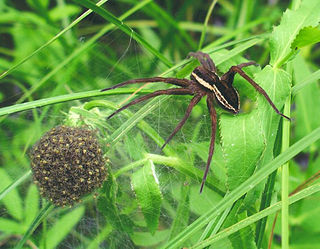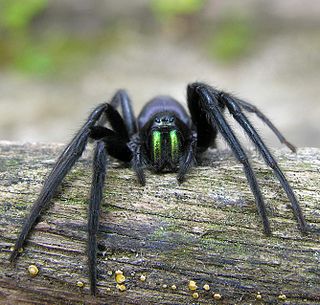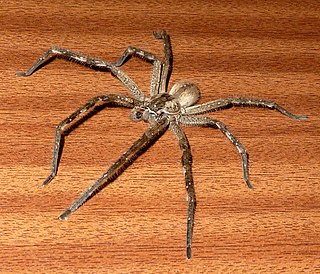
Huntsman spiders, members of the family Sparassidae, are known by this name because of their speed and mode of hunting. They are also called giant crab spiders because of their size and appearance. Larger species sometimes are referred to as wood spiders, because of their preference for woody places. In southern Africa the genus Palystes are known as rain spiders or lizard-eating spiders. Commonly, they are confused with baboon spiders from the Mygalomorphae infraorder, which are not closely related.

A tarantula hawk is a spider wasp (Pompilidae) that preys on tarantulas. Tarantula hawks belong to any of the many species in the genera Pepsis and Hemipepsis. They are one of the largest parasitoid wasps, using their sting to paralyze their prey before dragging it to a brood nest as living food; a single egg is laid on the prey, hatching to a larva which eats the still-living prey. They are found on all continents other than Antarctica.

Wasps in the family Pompilidae are commonly called spider wasps, spider-hunting wasps, or pompilid wasps. The family is cosmopolitan, with some 5,000 species in six subfamilies. Nearly all species are solitary, and most capture and paralyze prey, though members of the subfamily Ceropalinae are kleptoparasites of other pompilids, or ectoparasitoids of living spiders.

The Goliath birdeater belongs to the tarantula family Theraphosidae. Found in northern South America, it is the largest spider in the world by mass – 175 g (6.2 oz) – and body length – up to 13 cm (5.1 in) – but it is second to the giant huntsman spider by leg span. It is also called the Goliath bird-eating spider; the practice of calling theraphosids "bird-eating" derives from an early 18th-century copper engraving by Maria Sibylla Merian that shows one eating a hummingbird. Despite the spider's name, it rarely preys on birds.

Anya Sofia Corazon is a fictional superhero appearing in American comic books published by Marvel Comics. The character was created by writer Fiona Avery and artist Mark Brooks, and made her first appearance in Amazing Fantasy vol. 2 #1 under the pseudonym Araña and later in Young Allies vol. 2 #5 with the codename Spider-Girl. She is the Latina daughter of a Puerto Rican father and a Mexican mother.

Dolomedes is a genus of large spiders of the family Pisauridae. They are also known as fishing spiders, raft spiders, dock spiders or wharf spiders. Almost all Dolomedes species are semiaquatic, with the exception of the tree-dwelling D. albineus of the southeastern United States. Many species have a striking pale stripe down each side of the body.

Ant mimicry or myrmecomorphy is mimicry of ants by other organisms. Ants are abundant all over the world, and potential predators that rely on vision to identify their prey, such as birds and wasps, normally avoid them, because they are either unpalatable or aggressive. Spiders are the most common ant mimics. Additionally, some arthropods mimic ants to escape predation, while others mimic ants anatomically and behaviourally to hunt ants in aggressive mimicry. Ant mimicry has existed almost as long as ants themselves; the earliest ant mimics in the fossil record appear in the mid Cretaceous alongside the earliest ants. Indeed one of the earliest, Burmomyrma, was initially classified as an ant.
Spider behavior refers to the range of behaviors and activities performed by spiders. Spiders are air-breathing arthropods that have eight legs and chelicerae with fangs that inject venom. They are the largest order of arachnids and rank seventh in total species diversity among all other groups of organisms which is reflected in their large diversity of behavior.

Segestria florentina is the biggest European segestriid spider. Some vernacular names are green-fanged tube web spider and cellar spider, although the latter is not exclusive to this species.

A wasp is any insect of the narrow-waisted suborder Apocrita of the order Hymenoptera which is neither a bee nor an ant; this excludes the broad-waisted sawflies (Symphyta), which look somewhat like wasps, but are in a separate suborder. The wasps do not constitute a clade, a complete natural group with a single ancestor, as bees and ants are deeply nested within the wasps, having evolved from wasp ancestors. Wasps that are members of the clade Aculeata can sting their prey.

Episyron is a genus of wasps in the family Pompilidae which prey on spiders. Nine species are found in Europe.

Episyron quinquenotatus, the white-trimmed black wasp, is a North American species of pompilid spider hunting wasp.

Palystes castaneus is a species of huntsman spider found in parts of South Africa. It is common from Cape Town to Heidelberg, Western Cape, especially in forested areas. In scrub outside forested areas, it is replaced by Palystes superciliosus. It occurs mainly on plants, where it hunts insects. It has a body length of 17–22 mm. P. castaneus is the type species for the genus Palystes, and was first described by Pierre André Latreille in 1819.

The common rain spider, formerly P. natalius, is a species of huntsman spider native to Southern Africa. It is the most common and widespread species in the genus Palystes. In South Africa its distribution ranges from KwaZulu-Natal province in the east, then westwards to the provinces of Mpumalanga, Limpopo, Gauteng and North West in the north, and Eastern Cape and Western Cape in the south. It has a body length of 15–36 mm and a leg span of up to 110mm. The species was first described by Ludwig Carl Christian Koch in 1875.

Palystes is a genus of huntsman spiders, commonly called rain spiders or lizard-eating spiders, occurring in Africa, India, Australia, and the Pacific. The most common and widespread species is P. superciliosus, found in South Africa, home to 12 species in the genus. The name Palystes is derived from either the Latin palaestes or the Greek palaistes, meaning "wrestler". The genus was first described by Ludwig Carl Christian Koch in 1875.
Anoplius infuscatus is a species of spider wasp found mainly in Eurasia.
Paracyphononyx is a genus of spider wasps distributed in the tropics and warmer temperate regions; they differ from other pompilids in that they do not permanently disable the host spider but allow the spider to resume activity after the wasp has laid its egg on the spider while the wasp larva exists as koinobiont ectoparasitoid of the spider.

Pepsis grossa is a very large species of pepsine spider wasp from the southern part of North America, south to northern South America. It preys on tarantula spiders, giving rise to the name tarantula hawk for the wasps in the genus Pepsis and the related Hemipepsis. Only the females hunt, so only they are capable of delivering a sting, which is considered the second most painful of any insect sting; scoring 4.0 on the Schmidt sting pain index compared to the bullet ant's 4.0+. It is the state insect of New Mexico. The colour morphs are the xanthic orange-winged form and the melanic black winged form. In northern South America, a third form, known as "lygamorphic", has a dark base to the wings which have dark amber median patches and a pale tip.

Cantuaria borealis is a native New Zealand species of trapdoor spider.














